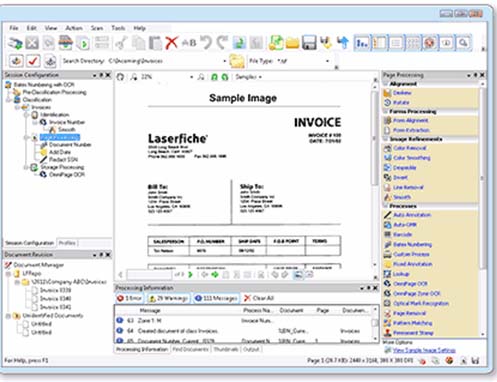In July, the Center for Digital Government released the results of its 10th annual digital counties survey.
Not surprisingly, the survey revealed that county governments are
focused on using technology to cut costs and improve service delivery.
One key strategy for achieving these goals is implementing shared
services.
A
shared service is one that is used by multiple parts of an organization
but purchased and supported by one area of the organization. For
example, rather than having different departments select and support
their own enterprise content management (ECM) systems, the IT department
purchases, implements and maintains one system that all departments
use.
The
digital counties survey revealed that 78% of the counties surveyed are
pursuing joint service delivery, an increase of eight percent over 2011.
But the trend toward shared services isn’t limited to government :Deloitte’s 2011 Global Shared Services Survey revealed that “shared services is increasing its reach into the ‘middle market.’”
These findings certainly reflect what we’re seeing among our customers. When you implement enterprise content management as a shared service, you minimize support and maintenance costs while also gaining the opportunity to:
· Leverage economies of scale.
· Share skillsets between organizations.
· Piggyback off the efforts of your peers.
Rather
than implementing ECM on a departmental basis, many organizations
across industries have implemented ECM as an enterprise-wide shared
service. For example, Texas A&M notes
that the benefits of offering a “centrally supported, enterprise-level
document management system provides many benefits,” including:
· Save costs through shared central support and eliminating the need for individual departments to maintain their own systems.
· Facilitate document sharing with colleagues while protecting confidential information.
· Enhance
overall office efficiency by eliminating paper-based processes,
improving information accessibility and decreasing the need to store
paper documents.
· Ensure continuity of operations by securing records and providing web access to critical documents during emergencies.
· Streamline
life-cycle management of business records with automatic enforcement of
consistent, organization-wide records policies.
· Support compliance requirements for document retention.
Computing
and Information Services (CIS), the central IT department for the Texas
A&M University System, supports the ECM shared service offering
across 11 System universities, seven state agencies and a comprehensive
health science center.
Beyond the Enterprise
Looking
beyond the walls of the enterprise, many government organizations are
teaming up to offer ECM as an inter-agency shared service. For example,
Loudoun County, VA, and the Loudoun County Public School District came
together and are implementing a shared ERP system with ECM integrated on
the back end.
According to Bill McIntyre, Division Manager of Enterprise IT at Loudoun County, VA,
“Laserfiche Rio provides the enterprise document management
functionality we need in our ERP system, along with standalone benefits
for a number of county departments—including a cost savings of $51,000 a
year on office supplies in the Department of Family Services alone. By
deploying ERP and ECM as a shared service, we’re leveraging economies of
scale and making more efficient use of our IT resources.”
Canada’s Essex County,
meanwhile, teamed up with seven county municipalities to purchase and
use Laserfiche WebLink as a public information portal. Wendy St. Amour,
Essex County’s IT Manager, explained, “The ability to share knowledge
and expertise with each other has proven to be very beneficial. By
taking a shared-service approach, we can develop a process once, and
with a few small changes, eight different organizations can benefit from
it.”
Law
enforcement agencies, too, are getting in on the shared-service action.
According to Renee Lura, Professional IT Services Manager for the City
of Fargo and an IT liaison/lead for the Red River Regional Dispatch Center,
“In the realm of public safety, sharing resources across agencies
allows everyone involved to get more bang for their buck.
Multi-jurisdictional agencies allow participants to pool their funding
so that they can invest in more sophisticated technology and provide
better, faster service to their communities.”
A Simple ECM Shared Service Maturity Model
According to Deloitte’s 2011 Global Shared Services Survey,
“Every organization approaches shared services differently and
regardless of the approach organizations are delivering year over year
incremental value to their bottom line.”
As
you consider implementing ECM as a shared service within your
organization, keep in mind that following a maturity model such as the
one outlined below can provide a roadmap to success.
1.
Localize your best practices. Analyze the processes conducted by your
business units. Calculate their lowest common denominator. Figure out
which process is most efficient—and then make it repeatable so you can
roll it out to the entire organization.
2.
Thoughtfully standardize across business units. Look at your metadata
models. Consider implementing a master model like the Dublin Core Set.
On the delivery side, develop a standardized skill set for your staff.
3.
Consolidate. Standardize the central system and customize the delivery.
Deployment-wise this means consolidating all of your content into one
ECM system and integrating to allow the users to access content through
any application.
4.
Cost benefits. This is where the economies of scale kick in. You’ve
developed your service level agreements and are rolling out a menu of
ECM functions in terms of head-count. At this stage your focus is no
longer just internal optimization. You are actually creating value for
the organization through your service offerings.
5.
Continuous review. Constantly refine your menu of offerings through
continuous and proactive auditing. Quality improvements are implemented
using formalized change management processes like Six Sigma.



